Seeking the Sources of Dust: Geochemical and Magnetic Studies on “Cryodust” in Glacial Cores from Southern Spitsbergen (Svalbard, Norway)
Abstract
:1. Introduction
2. Field and Laboratory Work
2.1. The Origins of Cryodust
2.2. Sampling in the Field
2.3. Cryodust Extraction
2.4. Geochemical Experiments
2.4.1. Sample Preparation
2.4.2. Monazite Dating by Electron Microprobe
2.5. Magnetic Experiments
2.5.1. Magnetic Susceptibility Experiments
2.5.2. Magnetic Hysteresis Experiments
3. Results
3.1. Geochemical Results
3.1.1. SEM–EDS Results
3.1.2. EMP Dating Results
3.2. Magnetic Results
3.2.1. Mass and Magnetic Susceptibility of Dust
3.2.2. Magnetic Susceptibility upon Heating/Cooling
3.2.3. Magnetic Hysteresis Results
4. Discussion
4.1. Geochemical Results
4.2. Magnetic Results
4.2.1. Susceptibility Results
4.2.2. Hysteresis Parameters
4.3. Dust Source Areas
4.3.1. Sedimentological Indicators
4.3.2. Geochemical Indicators
4.3.3. Magnetic Indicators
5. Conclusions
- The mineral fraction of aerosols (here defined as cryodust, < 6.10−5 m in size) deposited in glaciers of the Southern Spitsbergen includes an assemblage of common rock-forming phases accompanied by heavy minerals, such as monazite and zircon.
- Despite a low concentration in ice cores, sources of cryodust can be determined by a combination of geochemical, geochronological and/or magnetic methods.
- Chemical dating by electron microprobe analysis was effective for monazite grains as small as 20 µm, and yielded syn-Caledonian ages (429–423 Ma), pointing to nearby Nordaustlandet (NE Svalbard) as a possible source area, where a Caledonian orogenic belt is exposed to weathering.
- Magnetic analyses of the cryodust demonstrated the predominance of magnetite and an apparent lack the of FeIII-bearing minerals that are more characteristic of low-latitude weathering zones, indicating a lack of cross-latitudinal, far-distance transport of aerosols.
- Magnetite in association with pyrite and prevailing easterly winds suggest near-distance transport from the exposed Triassic rocks of the western part of Edgeøya.
- The presence of intact and non-oxidized framboids of pyrite may point to an origin in local cryoconite holes.
Author Contributions
Funding
Acknowledgments
Conflicts of Interest
Appendix A
Details of Geochemical Procedures and Methods
| Label | Th | U | Pb | Y | Age (Ma) | Error (Ma, 2σ) | Th* | |
|---|---|---|---|---|---|---|---|---|
| Storbreen | SIC4_mnz1 | 3.26 | 0.122 | 0.078 | 0.3908 | 436 | 38 | 3.5 |
| SIC4_mnz2 | 0.601 | 0.045 | 0.019 | 0.3345 | 425 | 175 | 0.71 | |
| SIC4_mnz3 | 3.75 | 0.082 | 0.082 | 0.1929 | 423 | 34 | 3.8 | |
| SIC4_mnz4 | 4.71 | 0.346 | 0.378 | 1.358 | 1365 | 34.5 | 5.6 | |
| Recherchebreen | RIC3_mnz1-1 | 4.56 | 0.190 | 0.108 | 0.6591 | 423 | 27 | 4.9 |
| RIC3_mnz2-1 | 3.09 | 0.178 | 0.056 | 1.176 | 256 | 36 | 3.5 | |
| RIC3_mnz3-1 | 4.24 | 0.264 | 0.427 | 0.6639 | 1780 | 42 | 4.9 | |
| RIC3_mnz3-2 | 4.15 | 0.208 | 0.373 | 0.7671 | 1644 | 42 | 4.6 | |
| RIC3_mnz4-1 | 1.22 | 0.057 | 0.034 | 0.3451 | 468 | 91 | 1.3 | |
| RIC3_mnz1-2 | 4.25 | 0.177 | 0.105 | 0.5828 | 445 | 29 | 4.6 | |
| RIC3_mnz5 | 3.41 | 0.104 | 0.082 | 0.5562 | 439 | 37 | 3.5 | |
| RIC3_mnz6 | 1.71 | 0.049 | 0.043 | 0.3691 | 445 | 72 | 1.8 | |
Appendix B
Appendix B.1. Details of Magnetic Procedures and Methods
Appendix B.2. Additional Figures and Tables
Appendix B.2.1. Magnetic Susceptibility Data
| Location | Sample Name | Mass (10−6 kg) of Filter | Mass of Residue (10−6kg) | κ - Bulk Susceptibility of Filter with Residue (SI vol.) | κ - Bulk Susceptibility of Residue (SI vol.) | χ Susceptibility per Mass m3/kg |
|---|---|---|---|---|---|---|
| Flatbreen | FIC2 | 106.7 | 28.6 | 1.420 × 10−6 | 1.450 × 10−6 | 5.065 × 10−7 |
| FIC3 | 115.06 | 36.6 | 9.130 × 10−7 | 9.460 × 10−7 | 2.584 × 10−7 | |
| Hansbreen | H6/1 | 100.2 | 21.9 | 1.333 × 10−6 | 1.369 × 10−6 | 6.262 × 10−7 |
| H6/2 | 90.6 | 12.3 | 1.018 × 10−6 | 1.104 × 10−6 | 9.005 × 10−7 | |
| H6/3 | 87.5 | 9.1 | 9.421 × 10−8 | 1.296 × 10−7 | 1.418 × 10−7 | |
| H6/4 | 89.4 | 11.1 | 8.742 × 10−7 | 9.095 × 10−7 | 8.211 × 10−7 | |
| Recherche-breen | RIC2 | 121.5 | 43.1 | 2.720 × 10−7 | 3.050 × 10−7 | 7.073 × 10−8 |
| RIC3 | 88.5 | 10.1 | 7.850 × 10−7 | 7.902 × 10−7 | 7.811 × 10−7 | |
| Storbreen | SIC2-SIC4 | 120.7 | 42.3 | 7.098 × 10−6 | 7.346 × 10−6 | 1.736 × 10−6 |
| Werenskiold-breen | W3 | 110.9 | 32.5 | 6.270 × 10−6 | 6.300 × 10−6 | 1.937 × 10−6 |
| W4 | 89.9 | 11.5 | 1.510 × 10−6 | 1.540 × 10−6 | 1.339 × 10−6 | |
| W1 | 87.2 | 8.8 | 7.030 × 10−7 | 7.889 × 10−7 | 8.934 × 10−7 | |
| W2 | 96.1 | 17.7 | 1.650 × 10−6 | 1.680 × 10−6 | 9.469 × 10−7 | |
| W5 | 107.2 | 28.9 | 3.590 × 10−6 | 3.620 × 10−6 | 1.255 × 10−6 | |
| W7 | 92.6 | 14.3 | 1.113 × 10−6 | 1.199 × 10−6 | 8.387 × 10−7 | |
| empty filter | 78.4 | −8.588 × 10−8 | −1.096 × 10−8 |
Appendix B.2.2. Magnetic Hysteresis Data
| Sample | Hc (kA/m) | Mr (nAm2) | Ms (nAm2) | Hcr (kA/m) | Mr/Ms | Hcr/Hc | Initial Slope (10−15 m3) | Initial Ferro (10−15m3) | Initial Para/dia (10−15m3) | Para/dia | Initial Ferro Normalized | Initial Para/dia Normalized |
|---|---|---|---|---|---|---|---|---|---|---|---|---|
| empty filter | 8.00 | 0.20 | 1.35 | 30.37 | 0.15 | 3.80 | 12.5 | 13.5 | −1.0 | dia | 1.08 | −0.08 |
| FIC2 | 8.00 | 1.48 | 14.90 | 25.89 | 0.10 | 3.24 | 157.0 | 150.6 | 6.4 | para | 0.96 | 0.04 |
| FIC3 | 8.40 | 1.97 | 15.50 | 27.27 | 0.13 | 3.25 | 186.4 | 175.5 | 10.9 | para | 0.94 | 0.06 |
| H6/1 | 10.64 | 0.15 | 0.85 | 32.43 | 0.17 | 3.05 | 20.3 | 8.3 | 12.0 | para | 0.41 | 0.59 |
| H6/2 | 7.36 | 0.10 | 0.77 | 28.92 | 0.13 | 3.93 | 27.9 | 7.0 | 20.8 | para | 0.25 | 0.75 |
| H6/3 | n/a | 0.08 | −0.21 | 38.53 | -- | -- | 14.9 | −1.8 | 16.7 | para | −0.12 | 1.12 |
| H6/4 | 5.04 | 0.12 | 1.51 | 25.63 | 0.08 | 5.09 | 22.9 | 13.7 | 9.2 | para | 0.60 | 0.40 |
| RIC2 | 10.40 | 0.40 | 2.60 | 30.02 | 0.16 | 2.89 | 19.9 | 28.6 | −8.6 | dia | 1.43 | −0.43 |
| RIC3 | 6.88 | 0.79 | 5.63 | 29.09 | 0.14 | 4.23 | 61.2 | 63.4 | −2.2 | dia | 1.04 | −0.04 |
| SIC2-SIC4 | 13.84 | 42.27 | 198.00 | 37.79 | 0.22 | 2.73 | 2423.0 | 2205.0 | 218.0 | para | 0.91 | 0.09 |
| W4 | 4.40 | 0.35 | 5.79 | 18.05 | 0.06 | 4.10 | 54.9 | 62.4 | −7.4 | dia | 1.14 | −0.14 |
| W1 | n/a | 0.06 | −0.17 | 46.51 | -- | -- | −3.1 | −0.7 | −2.4 | dia | −0.23 | −0.77 |
| W2 | 2.64 | 9.76 | 135.00 | 16.34 | 0.07 | 6.19 | 1.7 | 1.9 | −0.2 | dia | 1.12 | −0.12 |
| W3 | 5.04 | 5.73 | 77.00 | 18.75 | 0.07 | 3.72 | 855.1 | 820.2 | 34.9 | para | 0.96 | 0.04 |
| W5 | 7.68 | 1.50 | 15.50 | 24.79 | 0.10 | 3.23 | 191.7 | 156.1 | 35.6 | para | 0.81 | 0.19 |
| W7 | 7.12 | 0.89 | 8.60 | 25 | 0.10 | 3.51 | 74.8 | 98.0 | −23.3 | dia | 1.31 | −0.31 |
| SIC2-SIC4 (ht) | 7.44 | 40.20 | 175,00 | 13.96 | 0.23 | 1.88 | 3383.0 | 3438.0 | −55.0 | dia | 1.02 | −0.02 |
References
- Bullard, J.E.; Baddock, M.; Bradwell, T.; Crusius, J.; Darlington, E.; Gaiero, D.; Gassó, S.; Gisladottir, G.; Hodgkins, R.; McCulloch, R.; et al. High-latitude dust in the Earth system. Rev. Geophys. 2016, 54, 447–485. [Google Scholar] [CrossRef] [Green Version]
- Groot Zwaaftink, C.D.; Grythe, H.; Skov, H.; Stohl, A. Substantial contribution of northern high-latitude sources to mineral dust in the Arctic. J. Geophys. Res. D Atmos. 2016, 121, 13678–13697. [Google Scholar] [CrossRef]
- Harrison, S.P.; Kohfeld, K.E.; Roelandt, C.; Claquin, T. The role of dust in climate changes today, at the last glacial maximum and in the future. Earth-Sci. Rev. 2001, 54, 43–80. [Google Scholar] [CrossRef]
- Wegner, A.; Fischer, H.; Delmonte, B.; Petit, J.; Erhardt, T.; Ruth, U.; Svensson, A.; Vinther, B.; Miller, H. The role of seasonality of mineral dust concentration and size on glacial/interglacial dust changes in the EPICA Dronning Maud Land ice core. J. Geophys. Res. D: Atmos. 2015, 120, 9916–9931. [Google Scholar] [CrossRef] [Green Version]
- Rasmussen, S.O.; Seierstad, I.K.; Andersen, K.K.; Bigler, M.; Dahl-Jensen, D.; Johnsen, S.J. Synchronization of the NGRIP, GRIP, and GISP2 ice cores across MIS 2 and palaeoclimatic implications. Quat. Sci. Rev. 2008, 27, 18–28. [Google Scholar] [CrossRef] [Green Version]
- Zawierucha, K.; Baccolo, G.; Di Mauro, B.; Nawrot, A.; Szczuciński, W.; Kalińska, E. Micromorphological features of mineral matter from cryoconite holes on Arctic (Svalbard) and alpine (the Alps, the Caucasus) glaciers. Polar Sci. 2019, 22, 100482. [Google Scholar] [CrossRef]
- Kekonen, T.; Moore, J.; Perämäki, P.; Martma, T. The Icelandic Laki volcanic tephra layer in the Lomonosovfonna ice core, Svalbard. Polar Res. 2005, 24, 33–40. [Google Scholar] [CrossRef]
- Moroni, B.; Arnalds, O.; Dagsson-Waldhauserová, P.; Crocchianti, S.; Vivani, R.; Cappelletti, D. Mineralogical and Chemical Records of Icelandic Dust Sources Upon Ny-Ålesund (Svalbard Islands). Front. Earth Sci. 2018, 6, 187. [Google Scholar] [CrossRef]
- Stohl, A.; Berg, T.; Burkhart, J.F.; Fjǽraa, A.M.; Forster, C.; Herber, A.; Hov, Ø.; Lunder, C.; McMillan, W.W.; Oltmans, S.; et al. Arctic smoke—Record high air pollution levels in the European Arctic due to agricultural fires in Eastern Europe in spring 2006. Atmos. Chem. Phys. 2007, 7, 511–534. [Google Scholar] [CrossRef] [Green Version]
- Long, C.M.; Nascarella, M.A.; Valberg, P.A. Carbon black vs. black carbon and other airborne materials containing elemental carbon: Physical and chemical distinctions. Environ. Pollut. 2013, 181, 271–286. [Google Scholar] [CrossRef] [Green Version]
- Ohata, S.; Moteki, N.; Schwarz, J.; Fahey, D.; Kondo, Y. Evaluation of a Method to Measure Black Carbon Particles Suspended in Rainwater and Snow Samples. Aerosol Sci. Technol. 2013, 47, 1073–1082. [Google Scholar] [CrossRef]
- Spolaor, A.; Barbaro, E.; Mazzola, M.; Viola, A.P.; Lisok, J.; Obleitner, F.; Markowicz, K.M.; Cappelletti, D. Determination of black carbon and nanoparticles along glaciers in the Spitsbergen (Svalbard) region exploiting a mobile platform. Atmos. Environ. 2017, 170, 184–196. [Google Scholar] [CrossRef]
- Osmont, D.; Wendl, I.A.; Schmidely, L.; Sigl, M.; Vega, C.; Isaksson, E.; Schwikowski, M. An 800-year high-resolution black carbon ice core record from Lomonosovfonna, Svalbard. Atmos. Chem. Phys. 2018, 18, 12777–12795. [Google Scholar] [CrossRef] [Green Version]
- Nakazawa, F.; Fujita, K.; Takeuchi, N.; Fujiki, T.; Uetake, J.; Aizen, V.; Nakawo, M. Dating of seasonal snow/firn accumulation layers using pollen analysis. J. Glaciol. 2005, 51, 483–490. [Google Scholar] [CrossRef] [Green Version]
- Zawierucha, K.; Buda, J.; Azzoni, R.S.; Niśkiewicz, M.; Franzetti, A.; Ambrosini, R. Water bears dominated cryoconite hole ecosystems: Densities, habitat preferences and physiological adaptations of Tardigrada on an alpine glacier. Aquat. Ecol. 2019, 53, 543–556. [Google Scholar] [CrossRef] [Green Version]
- Bond, T.C.; Doherty, S.J.; Fahey, D.W.; Forster, P.M.; Berntsen, T.; DeAngelo, B.J.; Flanner, M.G.; Ghan, S.; Kärcher, B.; Koch, D.; et al. Bounding the role of black carbon in the climate system: A scientific assessment. J. Geophys. Res. D Atmos. 2013, 118, 5380–5552. [Google Scholar] [CrossRef]
- Gul, C.; Puppala, S.P.; Kang, S.; Adhikary, B.; Zhang, Y.; Ali, S.; Yang, L.; Li, X. Concentrations and source regions of light-absorbing particles in snow/ice in northern Pakistan and their impact on snow albedo. Atmos. Chem. Phys. 2018, 18, 4981–5000. [Google Scholar] [CrossRef] [Green Version]
- Sarangi, C.; Qian, Y.; Rittger, K.; Ruby Leung, L.; Chand, D.; Bormann, K.J.; Painter, T.H. Dust dominates high-altitude snow darkening and melt over high-mountain Asia. Nat. Clim. Chang. 2020, 10, 1045–1051. [Google Scholar] [CrossRef]
- Hagen, J.O.; Kohler, J.; Melvold, K.; Winther, J.-G. Glaciers in Svalbard: Mass balance, runoff and freshwater flux. Polar Res. 2003, 22, 145–159. [Google Scholar] [CrossRef] [Green Version]
- Semb, A.; Braekkan, R.; Joranger, E. Major ions in Spitsbergen snow samples. Geophys. Res. Lett. 1984, 11, 445–448. [Google Scholar] [CrossRef]
- Kekonen, T.; Moore, J.; Perämäki, P.; Mulvaney, R.; Isaksson, E.; Pohjola, V.; van de Wal, R.S.W. The 800 year long ion record from the Lomonosovfonna (Svalbard) ice core. J. Geophys. Res. D Atmos. 2005, 110. [Google Scholar] [CrossRef] [Green Version]
- Nawrot, A.P.; Migała, K.; Luks, B.; Pakszys, P.; Głowacki, P. Chemistry of snow cover and acidic snowfall during a season with a high level of air pollution on the Hans Glacier, Spitsbergen. Polar Sci. 2016, 10, 249–261. [Google Scholar] [CrossRef]
- Stachnik, Ł.; Majchrowska, E.; Yde, J.C.; Nawrot, A.P.; Cichała-Kamrowska, K.; Ignatiuk, D.; Piechota, A. Chemical denudation and the role of sulfide oxidation at Werenskioldbreen, Svalbard. J. Hydrol. 2016, 538, 177–193. [Google Scholar] [CrossRef] [Green Version]
- Simões, J.C. Environmental Interpretation from Svalbard Ice Cores. Ph.D. Thesis, University of Cambridge, Cambridge, UK, 1990. [Google Scholar]
- Dobrowolski, A.B. Historia Naturalna Lodu (The Natural History of Ice); Kasa Pomocy im. Dr. J. Mianowskiego: Warszawa, Poland, 1923. [Google Scholar]
- Rachlewicz, G. Paraglacial Modifications of Glacial Sediments Over Millennial to Decadal Time-Scales in the High Arctic (Billefjorden, Central Spitsbergen, Svalbard). Quaest. Geogr. 2010, 29, 59–67. [Google Scholar] [CrossRef] [Green Version]
- van der Meij, W.M.; Temme, A.J.A.M.; de Kleijn, C.M.F.J.J.; Reimann, T.; Heuvelink, G.B.M.; Zwoliński, Z.; Rachlewicz, G.; Rymer, K.; Sommer, M. Arctic soil development on a series of marine terraces on central Spitsbergen, Svalbard: A combined geochronology, fieldwork and modelling approach. SOIL 2016, 2, 221–240. [Google Scholar] [CrossRef] [Green Version]
- Rymer, K. Aeolian activity in central Spitsbergen (Ebba Valley) in the years 2012–2017. In Proceedings of the XXXVII Polar Symposium “Polar Change—Global Change”, Poznan, Poland, 7–10 June 2018; p. 61. [Google Scholar]
- Czeppe, Z. Przebieg Głównych procesów morfogenetycznych w południowo-zachodnim Spitsbergenie; Zeszyty Naukowe, U.J., Geograficzne, P., Eds.; Uniwersytet Jagielloński: Kraków, Poland, 1966; Volume 13. [Google Scholar]
- Kavan, J.; Láska, K.; Nawrot, A.; Wawrzyniak, T. High Latitude Dust transport altitude pattern revealed from deposition on snow, Svalbard. Atmosphere. accepted.
- Błaszczyk, M.; Jania, J.A.; Kolondra, L. Fluctuations of tidewater glaciers in Hornsund Fjord (Southern Svalbard) since the beginning of the 20th century. Pol. Polar Res. 2013, 34, 327–352. [Google Scholar] [CrossRef]
- Laska, M.; Barzycka, B.; Luks, B. Melting Characteristics of Snow Cover on Tidewater Glaciers in Hornsund Fjord, Svalbard. Water 2017, 9, 804. [Google Scholar] [CrossRef]
- Aleinikoff, J.N.; Schenck, W.S.; Plank, M.O.; Srogi, L.; Fanning, C.M.; Kamo, S.L.; Bosbyshell, H. Deciphering igneous and metamorphic events in high-grade rocks of the Wilmington Complex, Delaware: Morphology, cathodoluminescence and backscattered electron zoning, and SHRIMP U-Pb geochronology of zircon and monazite. Geol. Soc. Am. Bull. 2006, 118, 39–64. [Google Scholar] [CrossRef]
- Konečný, P.; Siman, P.; Holický, I.; Janák, M.; Kollárová, V. Metodika datovania monazite pomocou elektrónového mikroanalyzátora. Miner. Slovaca 2004, 36, 225–235. [Google Scholar]
- Konečný, P.; Kusiak, M.A.; Dunkley, D.J. Improving U-Th-Pb electron microprobe dating using monazite age references. Chem. Geol. 2018, 484, 22–35. [Google Scholar] [CrossRef]
- Montel, J.-M.; Foret, S.; Veschambre, M.; Nicollet, C.; Provost, A. Electron microprobe dating of monazite. Chem. Geol. 1996, 131, 37–53. [Google Scholar] [CrossRef]
- Kusiak, M.A.; Dunkley, D.J.; Whitehouse, M.J.; Wilde, S.A.; Sałacińska, A.; Konečný, P.; Szopa, K.; Gawęda, A.; Chew, D. Peak to post-peak thermal history of the Saglek Block of Labrador: A multiphase and multi-instrumental approach to geochronology. Chem. Geol. 2018, 484, 210–223. [Google Scholar] [CrossRef] [Green Version]
- Majka, J.; Be’eri-Shlevin, Y.; Gee, D.G.; Ladenberger, A.; Claesson, S.; Konecny, P.; Klonowska, I. Multiple monazite growth in the Åreskutan migmatite: Evidence for a polymetamorphic Late Ordovician to Late Silurian evolution in the Seve Nappe Complex of west-central Jamtland, Sweden. J. Geosci. 2012, 57, 3–23. [Google Scholar] [CrossRef] [Green Version]
- Paterson, G.A.; Zhao, X.; Jackson, M.; Heslop, D. Measuring, Processing, and Analyzing Hysteresis Data. Geochem. Geophys. Geosyst. 2018, 19, 1925–1945. [Google Scholar] [CrossRef]
- Dunlop, D.J. Theory and application of the Day plot (Mrs/Ms versus Hcr/Hc) 1. Theoretical curves and tests using titanomagnetite data. J. Geophys. Res. [Solid Earth] 2002, 107, EPM 4-1–EPM 4-22. [Google Scholar] [CrossRef] [Green Version]
- Oldfield, F.; Chiverrell, R.C.; Lyons, R.; Williams, E.; Shen, Z.; Bristow, C.; Bloemendal, J.; Torrent, J.; Boyle, J.F. Discriminating dusts and dusts sources using magnetic properties and hematite:Goethite ratios of surface materials and dust from North Africa, the Atlantic and Barbados. Aeolian Res. 2014, 13, 91–104. [Google Scholar] [CrossRef] [Green Version]
- Lanci, L.; Delmonte, B.; Kent, D.V.; Maggi, V.; Biscaye, P.E.; Petit, J.-R. Magnetization of polar ice: A measurement of terrestrial dust and extraterrestrial fallout. Quat. Sci. Rev. 2012, 33, 20–31. [Google Scholar] [CrossRef] [Green Version]
- Lanci, L.; Delmonte, B.; Salvatore, M.C.; Baroni, C. Insight Into Provenance and Variability of Atmospheric Dust in Antarctic Ice Cores During the Late Pleistocene From Magnetic Measurements. Front Earth Sci. 2020, 8, 258. [Google Scholar] [CrossRef]
- Balašov, J.A.; Peucat, J.J.; Teben’kov, A.M.; Ohta, Y.; Larionov, A.N.; Sirotkin, A.N. Additional Rb-Sr and single-grain zircon datings of Caledonian granitoid rocks from Albert I Land, northwest Spitsbergen. Polar Res. 1996, 15, 153–165. [Google Scholar] [CrossRef]
- Sawłowicz, Z. Framboids: From Their Origin to Application. Prace Mineralogiczne; Wydawnictwo oddziałuPAN w Krakowie: Kraków, Poland, 2000; Volume 88, p. 80. [Google Scholar]
- Birkenmajer, K.; Jania, J.; Pulina, M. Geological Map of the Hornsund Area; Uniwersytet Śląski: Katowice, Poland, 1990. [Google Scholar]
- Johansson, Å.; Maluski, H.; Gee, D.G. Ar-Ar dating of Caledonian and Grenvillian rocks from northeasternmost Svalbard-evidence of two stages of Caledonian tectonothermal activity in the high Arctic? Nor. J. Geol. Nor. Geol. Foren. 2001, 81, 263–281. [Google Scholar]
- Larrasoaña, J.C.; Roberts, A.P.; Liu, Q.; Lyons, R.; Oldfield, F.; Rohling, E.J.; Heslop, D. Source-to-sink magnetic properties of NE Saharan dust in Eastern Mediterranean marine sediments: Review and paleoenvironmental implications. Front Earth Sci. Chin. 2015, 3, 19. [Google Scholar] [CrossRef]
- Moskowitz, B.M.; Reynolds, R.L.; Goldstein, H.L.; Berquó, T.S.; Kokaly, R.F.; Bristow, C.S. Iron oxide minerals in dust-source sediments from the Bodélé Depression, Chad: Implications for radiative properties and Fe bioavailability of dust plumes from the Sahara. Aeolian Res. 2016, 22, 93–106. [Google Scholar] [CrossRef] [Green Version]
- Rodriguez-Navarro, C.; di Lorenzo, F.; Elert, K. Mineralogy and physicochemical features of Saharan dust wet deposited in the Iberian Peninsula during an extreme red rain event. Atmos. Chem. Phys. 2018, 18, 10089–10122. [Google Scholar] [CrossRef] [Green Version]
- Kandler, K.; Schneiders, K.; Heuser, J.; Waza, A.; Aryasree, S.; Althausen, D.; Hofer, J.; Abdullaev, S.F.; Makhmudov, A.N. Differences and Similarities of Central Asian, African, and Arctic Dust Composition from a Single Particle Perspective. Atmos. 2020, 11, 269. [Google Scholar] [CrossRef] [Green Version]
- Cong, Z.; Gao, S.; Zhao, W.; Wang, X.; Wu, G.; Zhang, Y.; Kang, S.; Liu, Y.; Ji, J. Iron oxides in the cryoconite of glaciers on the Tibetan Plateau: Abundance, speciation and implications. Cryosphere 2018, 12, 3177–3186. [Google Scholar] [CrossRef] [Green Version]
- Raiswell, R.; Hawkings, J.; Elsenousy, A.; Death, R.; Tranter, M.; Wadham, J. Iron in Glacial Systems: Speciation, Reactivity, Freezing Behavior, and Alteration During Transport. Front Earth Sci. Chin. 2018, 6, 222. [Google Scholar] [CrossRef] [Green Version]
- Agard, P.; Labrousse, L.; Elvevold, S.; Lepvrier, C. Discovery of Paleozoic Fe-Mg carpholite in Motalafjella, Svalbard Caledonides: A milestone for subduction-zone gradients. Geol. 2005, 33, 761–764. [Google Scholar] [CrossRef] [Green Version]
- Burzyński, M.; Michalski, K.; Nejbert, K.; Domańska-Siuda, J.; Manby, G. High-resolution mineralogical and rock magnetic study of ferromagnetic phases in metabasites from Oscar II Land, Western Spitsbergen—Towards reliable model linking mineralogical and palaeomagnetic data. Geophys. J. Int. 2017, 210, 390–405. [Google Scholar] [CrossRef]
- Michalski, K.; Lewandowski, M.; Manby, G. New palaeomagnetic, petrographic and 40Ar/39Ar data to test palaeogeographic reconstructions of Caledonide Svalbard. Geol. Mag. 2012, 149, 696–721. [Google Scholar] [CrossRef]
- Michalski, K.; Nejbert, K.; Domańska−Siuda, J.; Manby, G. New palaeomagnetic data from metamorphosed carbonates of Western Oscar II Land, Western Spitsbergen. Pol. Polar Res. 2014, 35, 553–592. [Google Scholar] [CrossRef] [Green Version]
- Michalski, K. Palaeomagnetism of metacarbonates and fracture fills of Kongsfjorden islands (western Spitsbergen): Towards a better understanding of late-to post-Caledonian tectonic rotations. Pol. Polar Res. 2018, 39, 51–75. [Google Scholar]
- Dudzisz, K.; Michalski, K.; Szaniawski, R.; Nejbert, K.; Manby, G. Palaeomagnetic, rock-magnetic and mineralogical investigations of the Lower Triassic Vardebukta Formation from the southern part of the West Spitsbergen Fold and Thrust Belt. Geol. Mag. 2019, 156, 620–638. [Google Scholar] [CrossRef]
- Lewandowski, M.; Szaniawski, R.; Krajewski, K.P. Dating reductive fluids flow by means of paleomagnetic data; example from the Triassic sandstones of the southern Spitsbergen. In Proceedings of the Abstracts of the 35th International Geological Congress, Cape Town, South Africa, 27 August–4 September 2016; p. 937. [Google Scholar]
- Grabiec, M.; Leszkiewicz, J.; Głowacki, P.; Jania, J. Distribution of snow accumulation on some glaciers of Spitsbergen. Pol. Polar Res. 2006, 27, 309–326. [Google Scholar]
- Dörnbrack, A.; Stachlewska, I.S.; Ritter, C.; Neuber, R. Aerosol distribution around Svalbard during intense easterly winds. Atmos. Chem. Phys. 2010, 10, 1473–1490. [Google Scholar] [CrossRef] [Green Version]
- Grabiec, M. Stan i współczesne zmiany systemów lodowcowych południowego Spitsbergenu w świetle badań metodami radarowymi; Prace Naukowe Uniwersytetu Śląskiego w Katowicach; Wydawnictwo Uniwersytetu Śląskiego: Katowice, Poland, 2017; Volume 3536, ISBN 9788322630143. [Google Scholar]
- Krajewski, K.P. The Botneheia Formation (Middle Triassic) in Edgeøya and Barentsøya, Svalbard: Lithostratigraphy, facies, phosphogenesis, paleoenvironment. Pol. Polar Res. 2008, 29, 319–364. [Google Scholar]
- Løvlie, R.; Torsvik, T.; Jelenska, M.; Levandowski, M. Evidence for detrital remanent magnetization carried by hematite in Devonian red beds from Spitsbergen; palaeomagnetic implications. Geophys. J.R.astr.Soc. 1984, 79, 573–588. [Google Scholar] [CrossRef] [Green Version]
- Cisek, M.; Makuch, P.; Petelski, T. Comparison of meteorological conditions in Svalbard fjords: Hornsund and Kongsfjorden. Oceanologia 2017, 59, 413–421. [Google Scholar] [CrossRef]
- Sulikowska, A.; Ziaja, W.; Wypych, A.; Mitka, K.; Maciejowski, W.; Ostafin, K. Summer weather conditions in 2005 and 2016 on the western and eastern coasts of south Spitsbergen. Pol. Polar Res. 2018, 39, 127–144. [Google Scholar] [CrossRef]
- Wawrzyniak, T.; Majerska, M.; Osuch, M. Hydrometeorological dataset (2014–2019) from the High Arctic unglaciated catchment Fuglebekken (Svalbard). Hydrol. Process. 2020. [Google Scholar] [CrossRef]
- Hanssen-Bauer, I.; Førland, E.J.; Hisdal, H.; Mayer, S.; Sandø, A.B.; Sorteberg, A. Climate in Svalbard 2100—A Knowledge Base for Climate Adaptation; NCCS report; Miljødirektoratet: Trondheim, Norway, 2019.
- Kok, J.F.; Parteli, E.J.R.; Michaels, T.I.; Karam, D.B. The physics of wind-blown sand and dust. Rep. Prog. Phys. 2012, 75, 106901. [Google Scholar] [CrossRef] [PubMed] [Green Version]
- Lambert, F.; Kug, J.-S.; Park, R.J.; Mahowald, N.; Winckler, G.; Abe-Ouchi, A.; O’ishi, R.; Takemura, T.; Lee, J.-H. The role of mineral-dust aerosols in polar temperature amplification. Nat. Clim. Chang. 2013, 3, 487–491. [Google Scholar] [CrossRef]
- Goelles, T.; Bøggild, C.E. Albedo reduction of ice caused by dust and black carbon accumulation: A model applied to the K-transect, West Greenland. J. Glaciol. 2017, 63, 1063–1076. [Google Scholar] [CrossRef] [Green Version]
- Zhang, Y.; Kang, S.; Cong, Z.; Schmale, J.; Sprenger, M.; Li, C.; Yang, W.; Gao, T.; Sillanpää, M.; Li, X.; et al. Light-absorbing impurities enhance glacier albedo reduction in the southeastern Tibetan plateau. J. Geophys. Res. D Atmos. 2017, 122, 6915–6933. [Google Scholar] [CrossRef]
- Lewis, G.; Osterberg, E.C.; Hawley, R.L.; Marshall, H.P.; Birkel, S.D.; Dibb, J.E.; Koffman, B.G.; Ferris, D.G.; Tedesco, M. Effects of Mineral Dust and Black Carbon on Albedo in the Western Greenland Ice Sheet Percolation Zone. In Proceedings of the AGU Fall Meeting Abstracts, Washington, DC, USA, 10–14 December 2018; Volume 2018, p. C31A-05. [Google Scholar]
- Durham, W.B.; Stern, L.A. Rheological Properties of Water Ice—Applications to Satellites of the Outer Planets. Annu. Rev. Earth Planet. Sci. 2001, 29, 295–330. [Google Scholar] [CrossRef] [Green Version]
- Åmli, R.; Griffin, W.L. Microprobe analysis of REE Minerals using empirical correction factors. Am. Mineral. 1975, 60, 599–606. [Google Scholar]


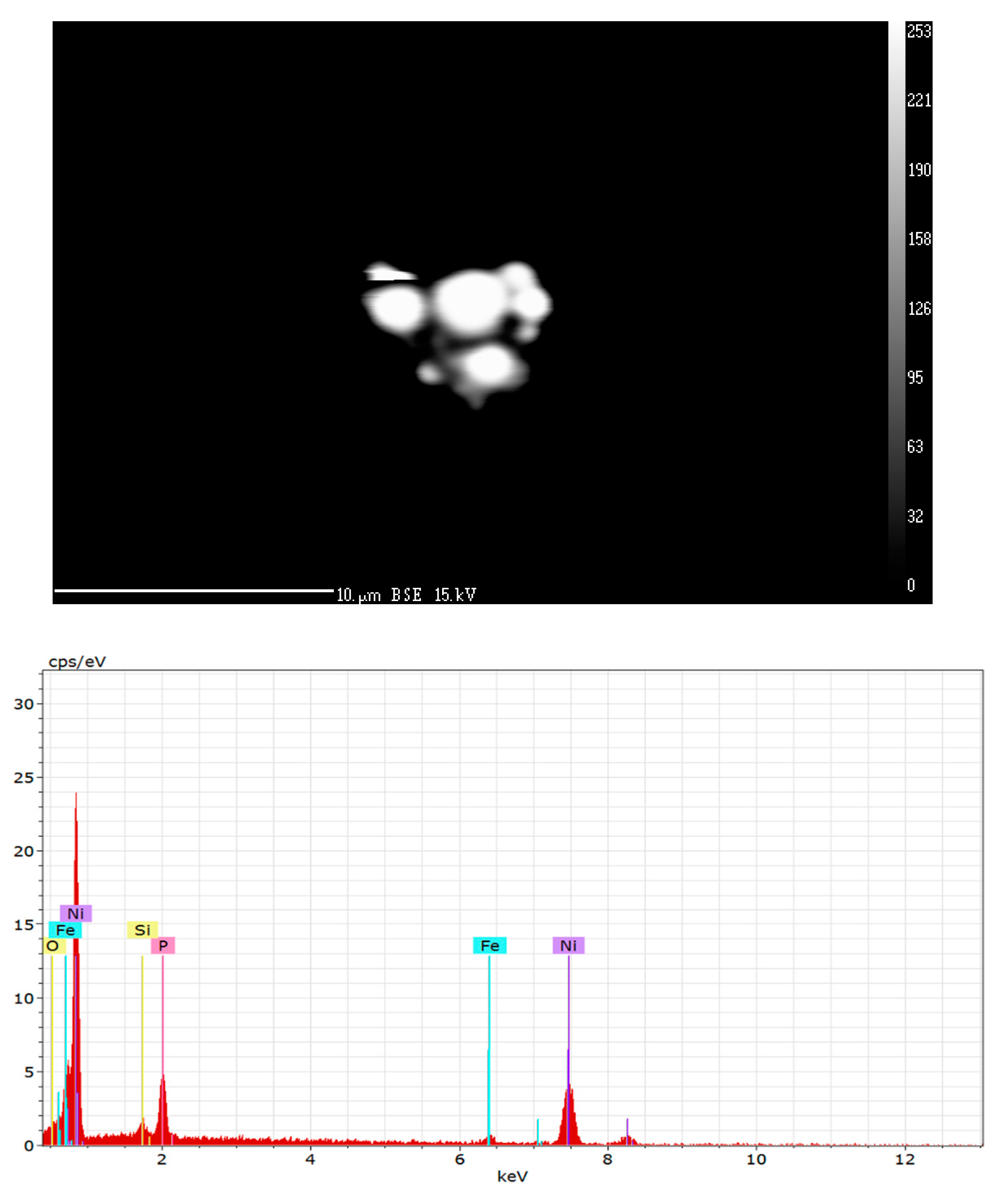

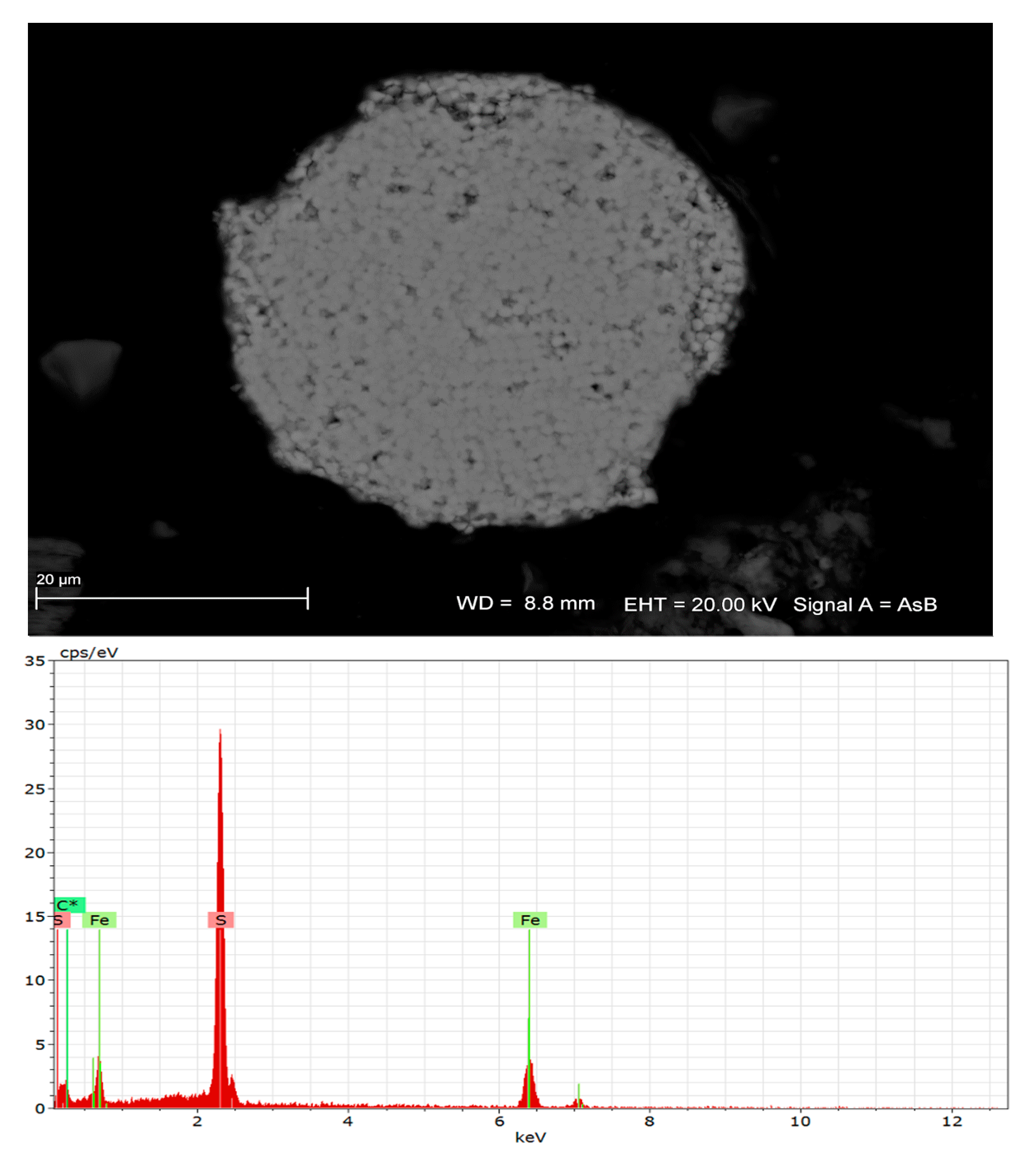
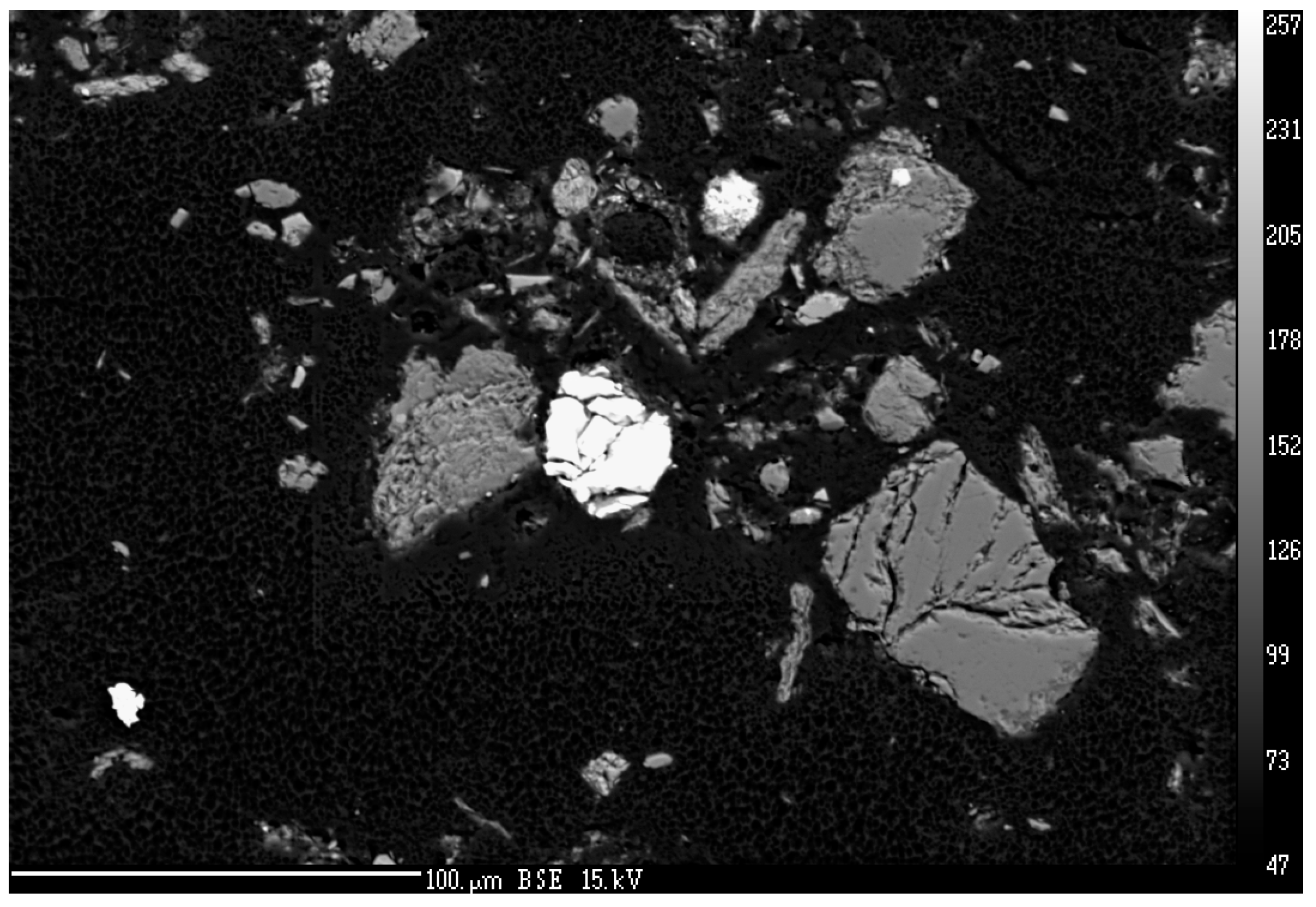
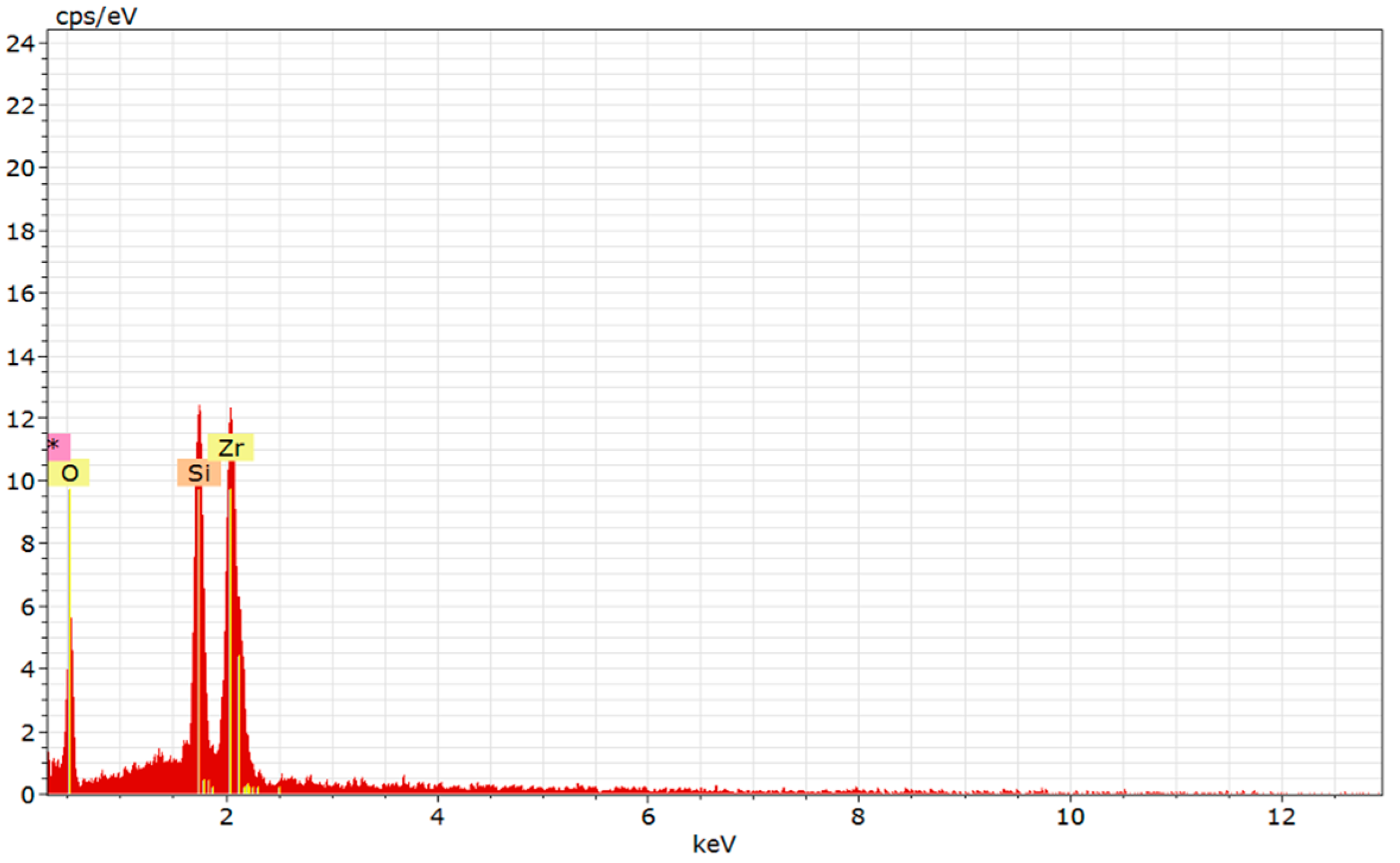
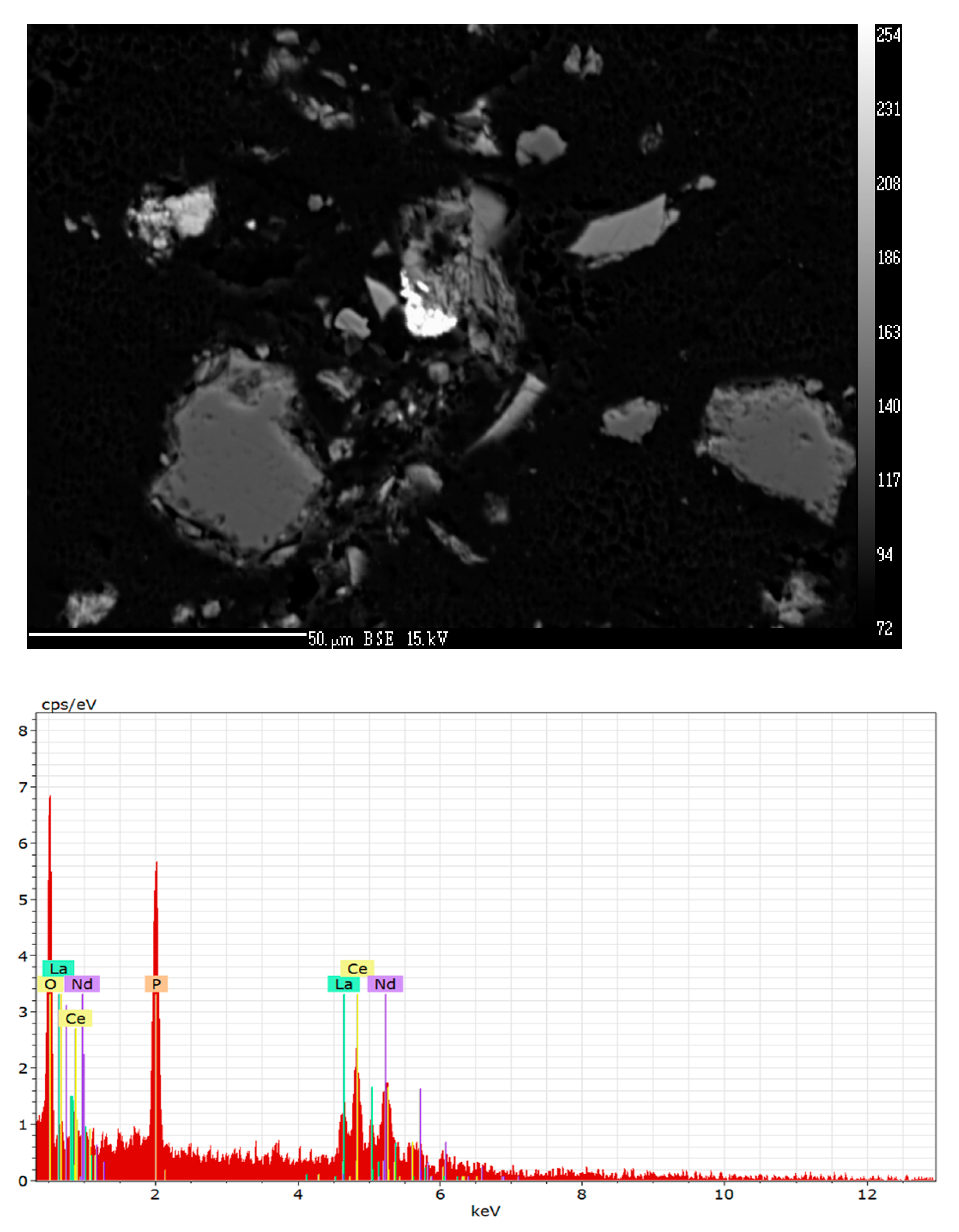

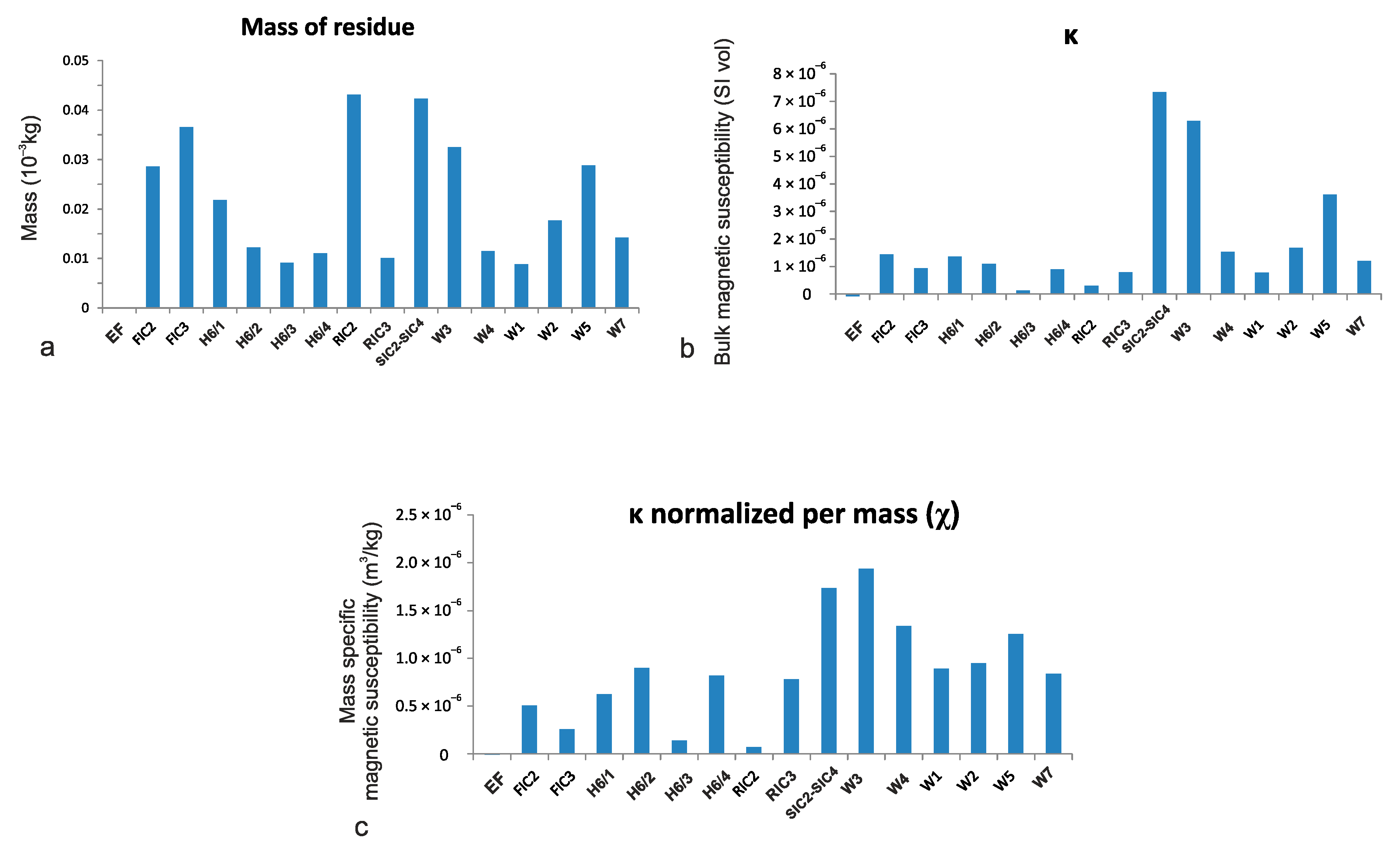
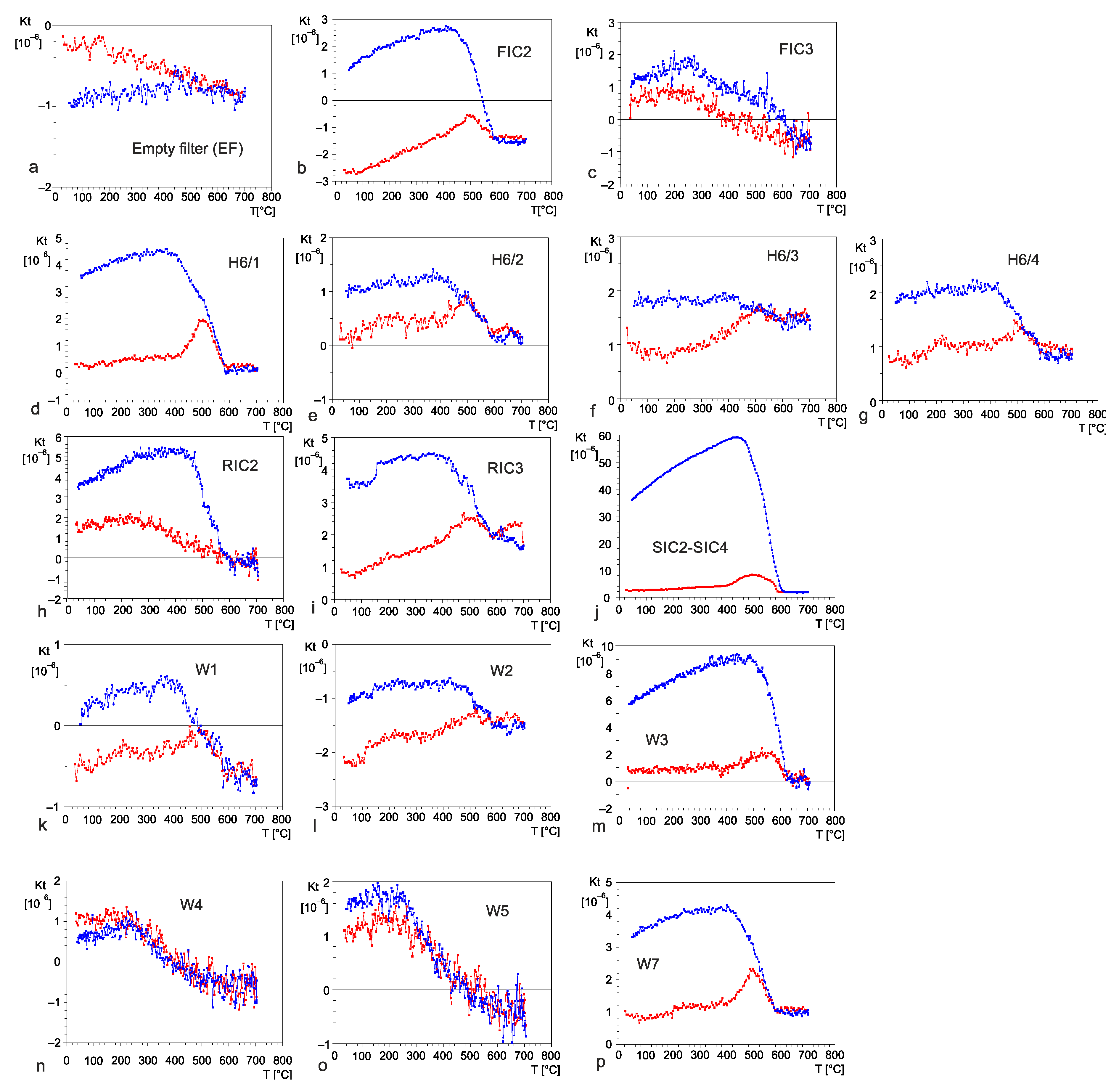
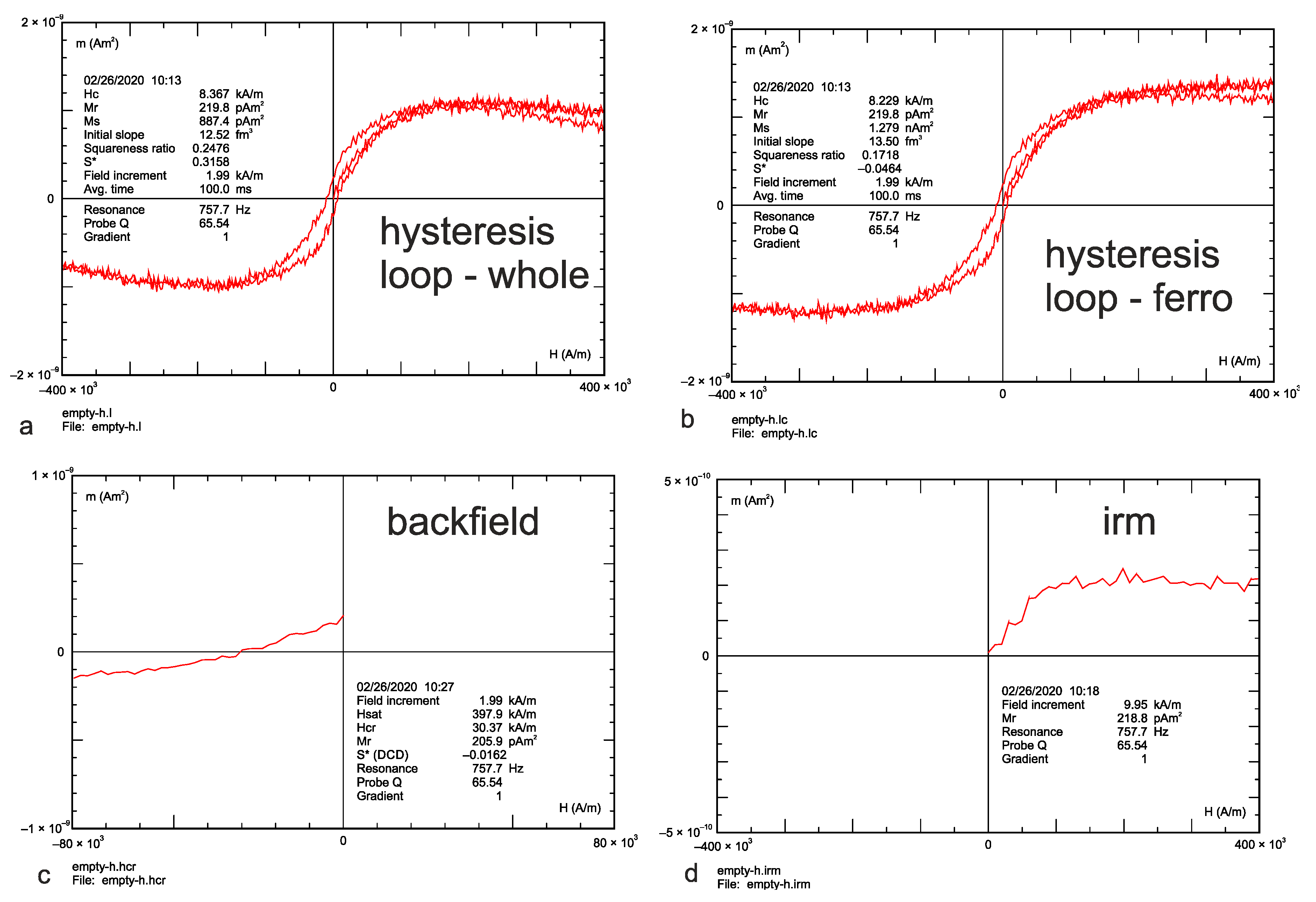

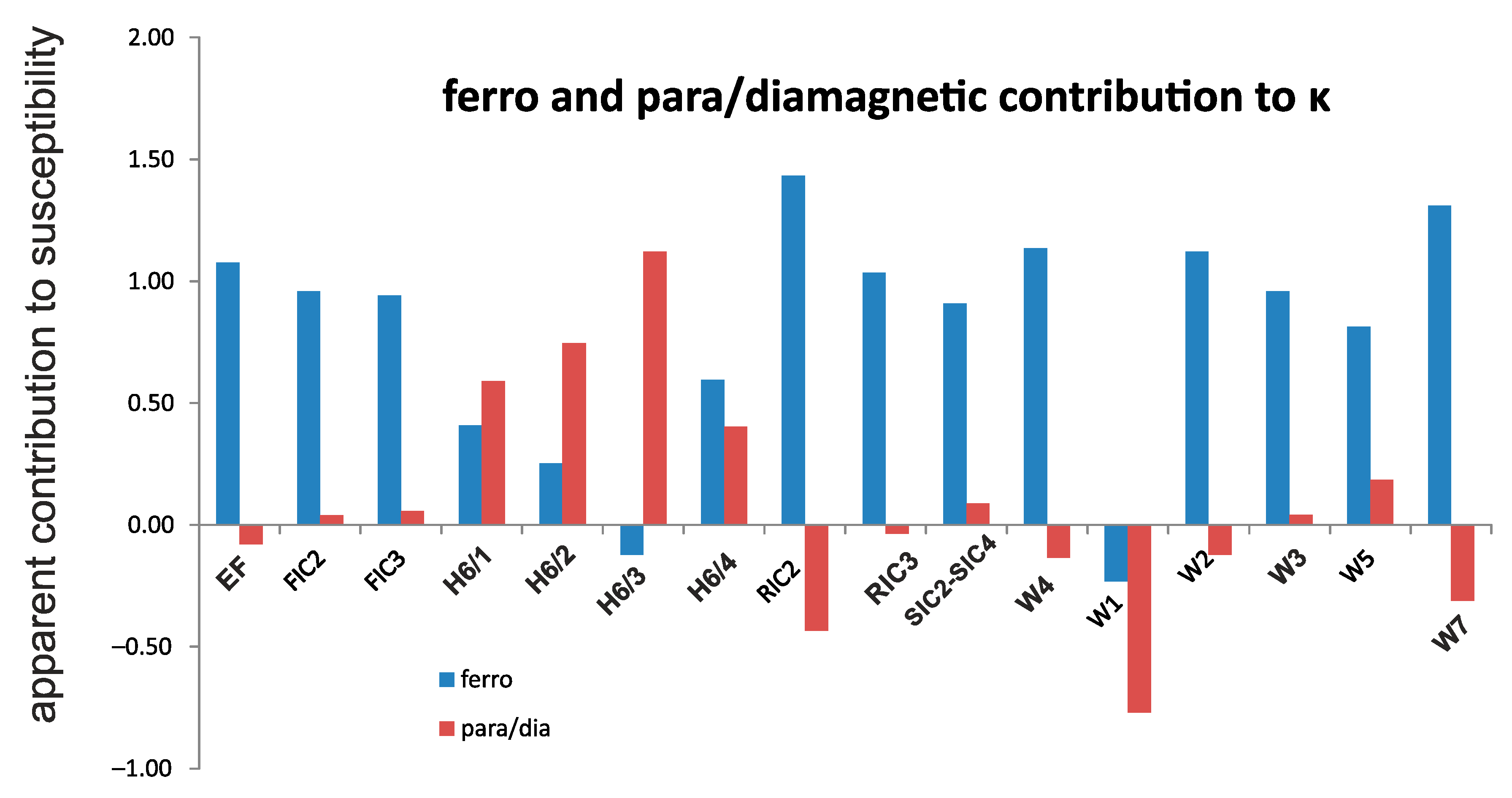


| Glacier | Area (km2) | Slope (°) | Mean Elevation (m a.s.l.) | ELA (m a.s.l.) |
|---|---|---|---|---|
| Recherchebreen | 120.2 | 3.6 | 430 | 555 |
| Hornbreen (Flatbreen) | 176.2 | 1.3 | 289 | 398 |
| Storbreen | 196.5 | 1.3 | 287 | 383 |
| Werenskioldbreen | 27.1 | 3.7 | 358 | 475 |
| Hansbreen | 53.8 | 1.7 | 291 | 342 |
| Glacier | Name | X | Y | Fe Class | ||
|---|---|---|---|---|---|---|
| dia | para | ferro | ||||
| Recherchebreen | RIC2 | 8,590,996 | 497,999 | L | H | |
| RIC3 | 8,588,426 | 505,117 | L | H | ||
| Hornbreen (Flatbreen) | FIC2 | 8,567,866 | 545,461 | L | H | |
| FIC3 | 8,568,521 | 545,461 | L | H | ||
| Storbreen | SIC2 | 8,571,862 | 522,493 | L | H | |
| SIC4 | 8,569,458 | 527,542 | L | H | ||
| Werenskioldbreen | W1 | 8,556,674 | 512,219 | too weak | ||
| W2 | 8,554,873 | 510,970 | L | H | ||
| W3 | 8,558,594 | 510,424 | L | H | ||
| W4 | 8,557,076 | 510,049 | L | H | ||
| W5 | 8,554,458 | 509,747 | L | H | ||
| W7 | 8,555,045 | 507,838 | L | H | ||
| Hansbreen | H6 (H6/1, H6/2, H6/3, H6/4) | 855,6118 | 515,814 | L | L | |
Publisher’s Note: MDPI stays neutral with regard to jurisdictional claims in published maps and institutional affiliations. |
© 2020 by the authors. Licensee MDPI, Basel, Switzerland. This article is an open access article distributed under the terms and conditions of the Creative Commons Attribution (CC BY) license (http://creativecommons.org/licenses/by/4.0/).
Share and Cite
Lewandowski, M.; Kusiak, M.A.; Werner, T.; Nawrot, A.; Barzycka, B.; Laska, M.; Luks, B. Seeking the Sources of Dust: Geochemical and Magnetic Studies on “Cryodust” in Glacial Cores from Southern Spitsbergen (Svalbard, Norway). Atmosphere 2020, 11, 1325. https://doi.org/10.3390/atmos11121325
Lewandowski M, Kusiak MA, Werner T, Nawrot A, Barzycka B, Laska M, Luks B. Seeking the Sources of Dust: Geochemical and Magnetic Studies on “Cryodust” in Glacial Cores from Southern Spitsbergen (Svalbard, Norway). Atmosphere. 2020; 11(12):1325. https://doi.org/10.3390/atmos11121325
Chicago/Turabian StyleLewandowski, Marek, Monika A. Kusiak, Tomasz Werner, Adam Nawrot, Barbara Barzycka, Michał Laska, and Bartłomiej Luks. 2020. "Seeking the Sources of Dust: Geochemical and Magnetic Studies on “Cryodust” in Glacial Cores from Southern Spitsbergen (Svalbard, Norway)" Atmosphere 11, no. 12: 1325. https://doi.org/10.3390/atmos11121325
APA StyleLewandowski, M., Kusiak, M. A., Werner, T., Nawrot, A., Barzycka, B., Laska, M., & Luks, B. (2020). Seeking the Sources of Dust: Geochemical and Magnetic Studies on “Cryodust” in Glacial Cores from Southern Spitsbergen (Svalbard, Norway). Atmosphere, 11(12), 1325. https://doi.org/10.3390/atmos11121325






